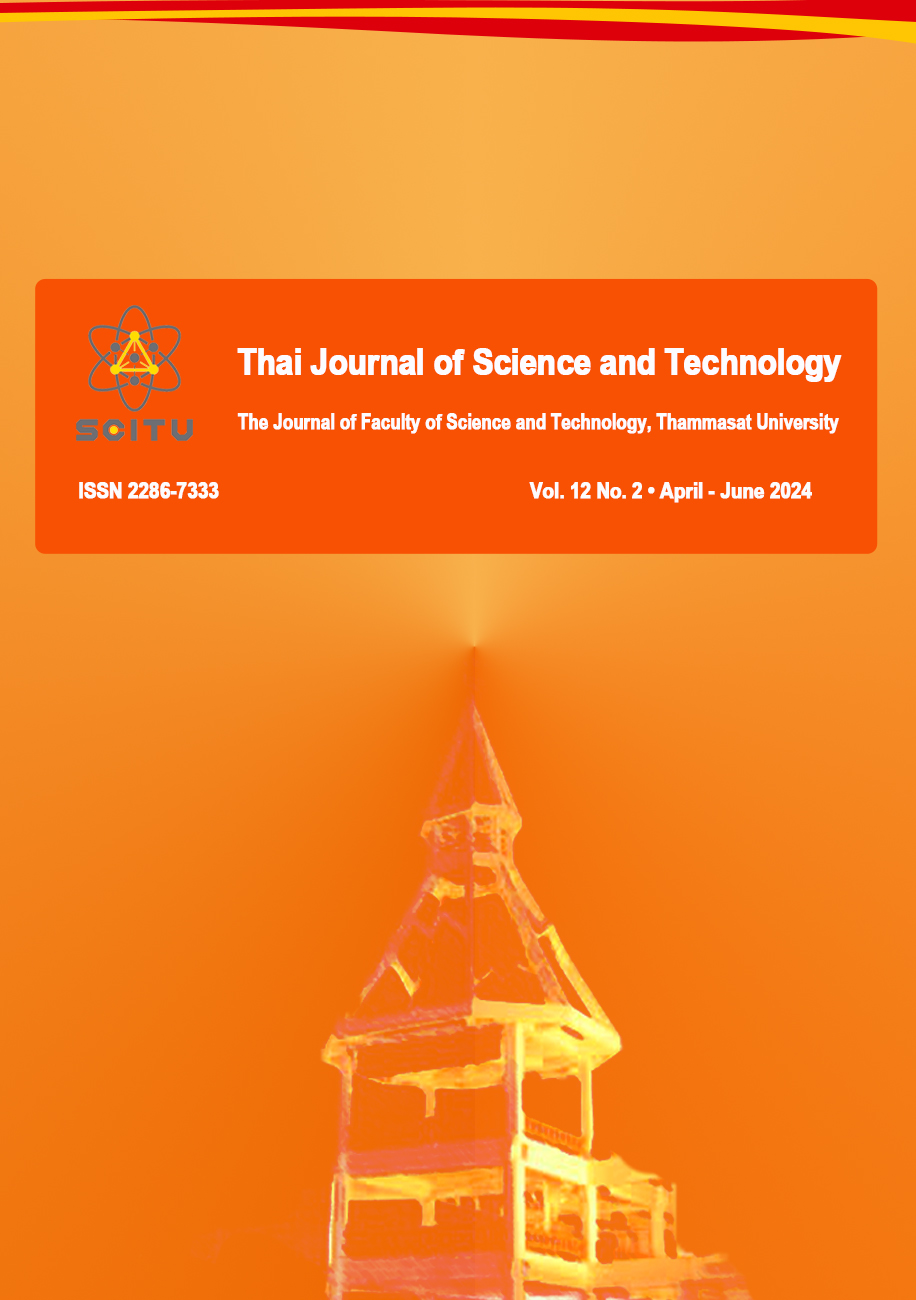ผลของบรรจุภัณฑ์ต่อคุณภาพการเก็บรักษาเมล็ดถั่วเหลือง
Main Article Content
บทคัดย่อ
การศึกษาบรรจุภัณฑ์ต่อคุณภาพของเมล็ดถั่วเหลืองพันธุ์เชียงใหม่ 60 วัตถุประสงค์เพื่อศึกษาผลของบรรจุภัณฑ์ต่อคุณภาพการเก็บรักษาเมล็ดถั่วเหลือง โดยวางแผนการทดลองแบบสุ่มสมบูรณ์ (Completely Randomized Design; CRD) ก่อนทำการวิจัยได้คัดเลือกคุณภาพเมล็ดเบื้องต้นโดยการคัดเลือกเมล็ดเสียและสิ่งปนเปื้อนออก รวมทั้งลดความชื้นของเมล็ดให้มีความชื้นไม่เกินร้อยละ 10 ทำการบรรจุเมล็ดถั่วเหลืองในถุงพลาสติกถุงละ 10 กิโลกรัม แบ่งการทดลองเป็น 4 ทรีตเมนต์ คือ 1) กระสอบพลาสติกสานโพลีโพรพิลีน (polypropylene; PP), 2) กระสอบพลาสติกสาน PP ร่วมกับถุงพลาสติกชนิด โพลีเอทิลีน (polyethylene; PE), 3) กระสอบพลาสติกสาน PP ร่วมกับถุงพลาสติกชนิด linear low-density polyethylene; LLDPE และ 4) กระสอบพลาสติกสาน PP เคลือบลามิเนต (laminated) นำเมล็ดถั่วเหลืองทั้งหมดไปเก็บรักษาที่อุณหภูมิ 20 องศาเซลเซียส (30±5% RH) เป็นระยะเวลานาน 8 เดือน ทำการสุ่มตัวอย่างมาตรวจสอบคุณภาพทุก 30 วัน จำนวน 3 ซ้ำต่อทรีตเมนต์ ผลการทดลองพบว่าบรรจุภัณฑ์กระสอบสานพลาสติก PP เคลือบด้วยลามิเนต มีประสิทธิภาพในการชะลอการเกิดความผิดปกติของเมล็ดถั่วเหลือง รวมถึงมีการเปลี่ยนแปลงสี (L*, C* และ hº) จากสีเหลืองไปเป็นสีน้ำตาลช้ากว่าบรรจุภัณฑ์ชนิดอื่น ในขณะที่บรรจุภัณฑ์กระสอบสานพลาสติก PP ทำให้เมล็ดถั่วเหลืองมีการสูญเสียน้ำหนักมากที่สุด ซึ่งสัมพันธ์กับปริมาณความชื้นในเมล็ดลดลงมากที่สุด อย่างไรก็ตามชนิดของบรรจุภัณฑ์ไม่มีผลต่อการเปลี่ยนแปลงปริมาณโปรตีนภายในเมล็ด และการเปลี่ยนแปลงปริมาณก๊าซออกซิเจน (O2) และก๊าซคาร์บอนไดออกไซด์ (CO2) ในบรรจุภัณฑ์ ตลอดระยะเวลาการเก็บรักษา 8 เดือน
Article Details

อนุญาตภายใต้เงื่อนไข Creative Commons Attribution-NonCommercial-NoDerivatives 4.0 International License.
บทความที่ได้รับการตีพิมพ์เป็นลิขสิทธิ์ของคณะวิทยาศาสตร์และเทคโนโลยี มหาวิทยาลัยธรรมศาสตร์ ข้อความที่ปรากฏในแต่ละเรื่องของวารสารเล่มนี้เป็นเพียงความเห็นส่วนตัวของผู้เขียน ไม่มีความเกี่ยวข้องกับคณะวิทยาศาสตร์และเทคโนโลยี หรือคณาจารย์ท่านอื่นในมหาวิทยาลัยธรรมศาสตร์ ผู้เขียนต้องยืนยันว่าความรับผิดชอบต่อทุกข้อความที่นำเสนอไว้ในบทความของตน หากมีข้อผิดพลาดหรือความไม่ถูกต้องใด ๆ
เอกสารอ้างอิง
Department of internal trade. (2023). Agricultural product season calendar 2023. Retrieved from http://agri.dit.go.th/index.php/department_doc/3. 3 July 2023.
Duangpatra, J. (1986). Seed technology. Location: Faculty of Agriculture (Department of Agronomy). Kasetsart University, Bangkhen Campus, Bangkok. 13 pp.
Jittham, O., Damrhikhemtrakul, W., Bangwaek, C. and Suwannachome, O. (2008). Report on research and development work on plants and agricultural technology, the experiment ended in fiscal year 2008. 144-145 p.
Juntakool, S. (2006). Teaching materials for seed physiology. Location: Department of Agronomy Faculty of Agriculture, Kasetsart University. Bangkok.
Leekitwattana, J. (1997). Classification of low-density polyethylene. Location: The Department of Science Service, 28 p.
National Bureau of Agricultural Commodity and Food Standards. (2019). Thai agricultural standard 4903-2019, (Good Agricultural Practices for Soybean Seed Production). 10 p.
Rachtanapun, P., & Tongdeesoontorn, W. (2007). Extending shelf life of brown rice by using different packaging materials and oxygen absorber. Agricultural Science Journal, 38,(5Suppl.), 229-233.
Simla, S., Boontang, S., & Benchasri, S. (2017). Total Phenolic Content and Antioxidant Activities in Seed, Germinated Seed and Dried Germinated Seed. Khon Kaen Agricultural Journal, 45(Suppl.1), 1259-1264.
Siriphanich, J. (2003). Physiology and post-harvest technology of fruits and vegetables. Location: Department of Agronomy, Faculty of Agriculture, Kasetsart University, Bangkok. 398 p.
Sukhothai provincial agriculture and cooperatives office. (2017). Soybean: Information for agricultural product planning in Sukhothai Province (Document No. 10/2017). Sukhothai.
Suwanasorn, P. (1997). Effects of reducing humidity and vacuum packing on the viability of soybean seeds during storage. (Master's Degree). Chiang Mai University, Chiangmai.
Thakur, V., Nawalagatti, C.M., Chetti, M.B., Hilli, J.S., & Patil, R.V. (2023). Seed Quality Behaviour Variation of Moth Bean during Storage in Different Packaging. International Journal of Environment and Climate Change, 13, 2893-2898.
Toole, V.K., Bailey, W.K., & Toole, E.H. (1964). Factors Influencing Dormancy of Peanut Seeds. Plant Physiology, 39, 822-832.


